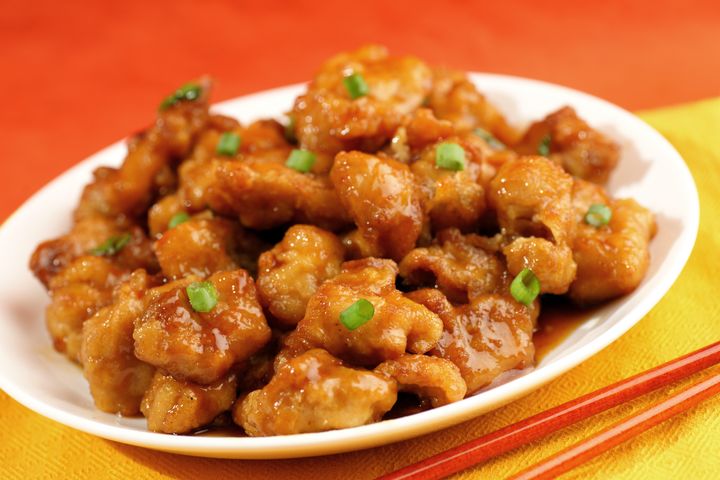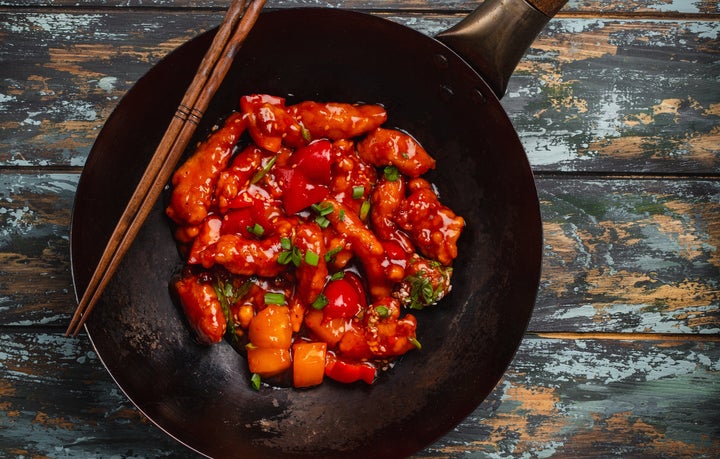
When I was younger, I was made to feel really embarrassed that I had to help out at my parents’ Chinese takeout restaurant in suburban Long Island, New York. I hated that I was a living stereotype, escaping into schoolwork at the tables in the waiting area to get out of tasks like stapling boxes and bagging fried noodles. I resented that I had way more daily parental supervision than my classmates who lived the freer lives of latchkey kids. I was mortified that kids didn’t want to sit next to me on the bus because my winter coats smelled like old fry oil.
Moreover, I felt provincial that, no, I’d never had chicken nuggets before I’d started school, cheeseburgers were a special treat and pizza was for parties. And therein lay the rub.
Because, although those are far from “healthy” foods, popular American culture indoctrinates in us that Chinese food is inherently unhealthy. But that’s simply not true. What is true is that a typical Chinese diet is very veggie-heavy and that many of the dishes Americans think of as quintessential Chinese are actually Americanised Chinese dishes adapted to Western tastes out of necessity. A mainstream market for “authentic” Chinese food simply didn’t really exist when I was growing up.
Legendary “Iron Chef” Ming Tsai told HuffPost, “When Chinese food was Americanised, the ratio of protein to vegetables changed. Americans want more protein, less vegetables. [Yet] the reason Asian cuisine is so healthy is the higher ratio of vegetables to protein in their dishes because protein is much more expensive” and scarcity made meat more of an accent than a showpiece.
However, “in the ’80s, we didn’t think much about the consequences of our consumption,” explained Justin Lee, the chef and co-founder of Fat Choy, a New York Times-recognised “kind of Chinese, also vegan” restaurant in Englewood, New Jersey. It’s was just how our people ate.
Kevin Chanthasiriphan, co-founder of the revolutionary high-protein, low-oil Immi instant ramen noodles, and whose family ran Thai-Chinese restaurants, echoed that sentiment. “My parents didn’t really understand nutrition very well, so they kind of let me eat whatever I wanted to eat, but their only request was that I have a serving of vegetables alongside my food.”
So the dishes that many think of as representative of Chinese food are actually another genre: American Chinese regional cuisine.
Many of those creations, products of consumer demand, have been historically skewed toward the craveable deep-fried, sweet and battered routes we Americans love so much, and heavy on sugar, sauce, protein and carbs.
Now that Americans are becoming more health and nutrition conscious, first- and second-generation Chinese American culinary pioneers are looking to change that. Not only did it inform the careers of Chanthasiriphan and Lee, this vegetable-forward approach was a hallmark for Mike Wang as well, using it to transition from cardiothoracic surgery to found Mógū Modern Chinese Kitchen, now a fast-growing fast-casual American Chinese concept on Long Island that uses smart tech to make Westernised takeout favourites more heart-healthy.
With contemporary attitudes and awareness in mind, there are a handful of old-school American Chinese dishes that Tsai, Lee, Chanthasiriphan, Wang and I feel a little guilty or just funny about ordering for health reasons.

Crab Rangoon/Cream Cheese Wontons
By no token of the imagination are these an actual Chinese appetiser. Chanthasiriphan noted, “This is a very interesting and uniquely American dish. It has a Burmese name, but it’s definitely not Burmese food.”
According to most sources, the origin is traced back to Victor Bergeron, whose Trader Vic’s restaurant and heritage are not Chinese whatsoever. In fact, the first time I ever had one of these, I was 12 years old. It wasn’t until I visited my Canadian Cantonese uncle’s family restaurant that I first heard of these deep-fried, flower-shaped pouches of hot, bubbling cream cheese and imitation crab, zesty with diced onion and scallion.
Before long, everyone was adding them to their Chinese takeout menus, and my parents were no exception. However, my mom would cringe when I hankered for them.
“There are egregious amounts of sugar in most of these; I’ve definitely tasted sugary crab Rangoon filling,” Lee said. On top of that, like most Asians, Chanthasiriphan said, “my family is lactose intolerant, so we rarely ever order this dish!”
Sesame Chicken/General Tso’s Chicken/Orange Chicken
The technique used to make these dishes is one of the most dramatic to watch. I would be awed as my dad or cousin scooped a ladleful of pure white sugar and mix it midair into the chicken and sauce as they flipped the wok with the other hand, flames roaring from the uncovered burner. However, this impressive feat is one of the things that made my parents limit how often I could eat this American favourite. The amount of sugar required to make the sauce as thick, syrupy and sweet as American palates like is alarming.
And what makes this dish so texturally delightful ― a lightly crisp coating on nuggets of rough-cut meat ― is from deep-frying, sometimes twice. In fact, this was one of the first American Chinese dishes Wang reinvented when he launched Mógū, developing an air-fry technology to reduce the high-temperature deep-frying, in addition to utilising fruit juices and reducing the sauce quantity to cut down on sugars.
But even without that option, this dish still isn’t necessarily a hard no for us. Chanthasiriphan confessed, “I’m not a fan of the overall macronutrient profile, but I’m very partial to these types of dishes. I still order them on occasion, but they’re very much a guilty pleasure!”
Egg Foo Young
This dish, created in the U.S. as a thrifty way to use up scraps, is secretly full of vegetables and a decent amount of the meat of your choice. But that’s not enough to make up for the fact that it’s heavily fried.
Chanthasiriphan admitted he loves this dish and finds it a bit more balanced than the General Tso’s, orange and sesame chicken dishes “as it does have vegetables in it and is less saccharine.” But as Wang assessed, “It has very little nutritional value, and fried eggs contribute to a high fat content that is a poor factor for cardiovascular health,” adding, “it’s extremely heavy without a great deal of flavor without the gravy, which makes it even worse.” That’s because all brown gravies are made with fat and drippings.
My parents used to allow me to eat this only if I used the gravy as a dipping sauce and not a coat, and that’s the only way I’ll eat it to this day to avoid the feeling of “all this oil just sitting there,” as Wang described it.

Sweet And Sour Chicken/Pork/Shrimp
You’ll see sweet and sour dishes in China, but they’re not at all close to what’s served at American Chinese restaurants. Personally, I’m all for a puffy, airy, crisp chunk of golden-fried meat, but this also falls on the “only sometimes, with sauce on the side” list.
For this dish, the primary culprit is actually less the frying than the batter and sauce. As Tsai pointed out, “There is a big difference between batter and coating a protein with cornstarch,” a common Chinese technique called velveting, which preserves moisture and tenderness. “Once you have a wet batter,” which is used in recipes such as beer-battered fish as well as sweet and sour dishes, “it absorbs more oil and fat. And if a protein is battered, it’s larger in volume and will then need more sauce to coat it,” which leads to higher sugar intake. Plus, he said, “in America, when people order sweet and sour chicken, they want to be eating a lot of chicken and not the carrots, celery, bell pepper, etc.,” which means near-nil nutritional value.
This dish is a hard no for Lee. “I’m turned off by the nuclear-red candy glaze, and I’ve had versions that seemed like they were battered with pancake mix,” he said with a laugh.
Lo Mein/Chow Mein
Whether you call it lo mein (East Coast) or chow mein (West Coast), the American version of this noodle dish is one of my favourite things to eat of all time. I absolutely adore soy-soaked spongey egg noodles mixed with all the meats and veggies and will still beg American Chinese takeout chefs to make my dad’s off-menu version, with beef, pork, chicken, broccoli, mushrooms, snow peas and a scrambled egg. But for Chanthasiriphan, it’s something he simply never orders out anymore.
“You would think it’s relatively healthy with some carbs, some protein, some vegetables ― it’s a fan favourite. But the noodles I find to be a source of empty calories. And to prevent it from sticking to the wok, you need a lot of oil, which is the secret to really delicious chow mein.”
Are there ways to lighten these dishes up so we can keep enjoying them?
As Americans with Chinese heritage working in the food industry and, for the most part, folks who grew up eating American Chinese dishes as beloved additions to our childhood diets, this is the ultimate challenge and the question that’s led these chefs to usher in a modern age of American Chinese food. Until restaurants like Fat Choy and Mógū go national and until brands like MingsBings and Immi are in every freezer and pantry shelf, there still are a few things we can keep in mind when we absolutely must have these treat-yourself dishes.
Ask for less sugar for sauces that are made to order, like General Tso’s, sesame chicken and orange chicken, or just ask for less sauce or sauce on the side so you can control the amount, like with egg foo young gravy or sweet and sour sauce. Ask for less oil for noodle dishes or ask that your crab Rangoon or sweet and sour dish be drained extra well. And there’s nothing stopping you from using the pizza-dab napkin technique to soak up excess oil.
For home cooks, Lee suggested “using starches to thicken sauces to replace some of the coating attributes of caramelisation, reducing sugar, using mushrooms in place of salt or soy sauce, frying in healthier oils and, of course, cooking and eating more vegetables.” These are principles he incorporates at Fat Choy and they are hacks Wang has employed at Mógū, in addition to Wang’s use of air fryers, his patented smart woks and whole ingredients.
And, of course, use balance and moderation as you plate out your haul.
“Instead of having just a pound of sugary sauces, fried chicken, think with the more Chinese sensibility of having a variety of dishes with healthier choices,” Lee advised.
If you do that, you can order whatever you want, still. I know I do.